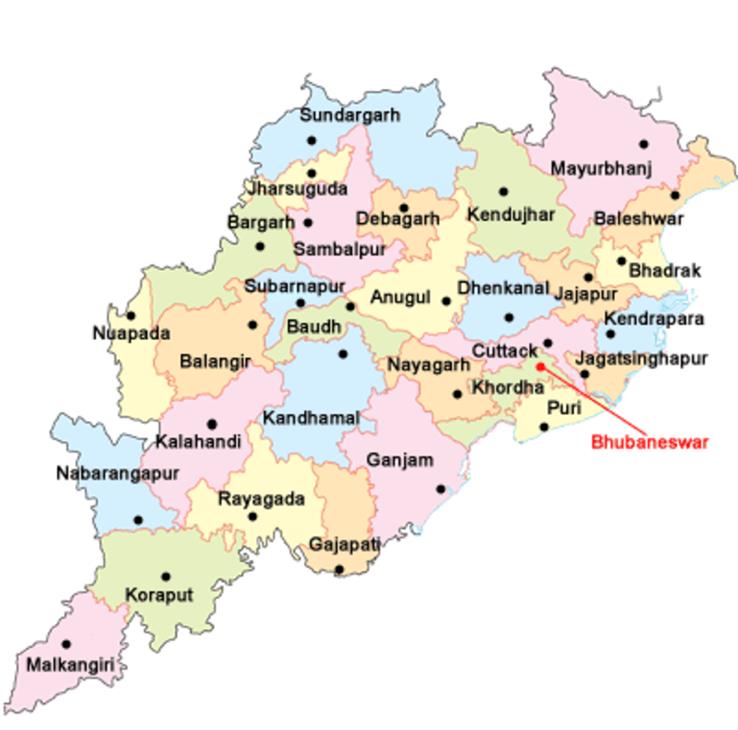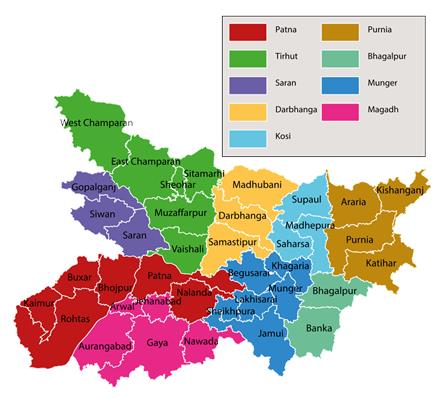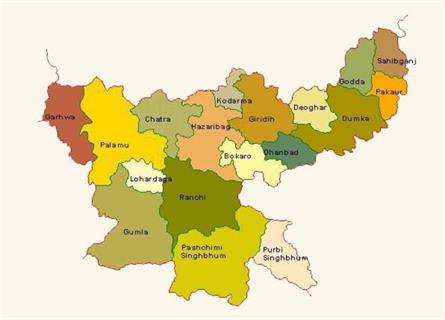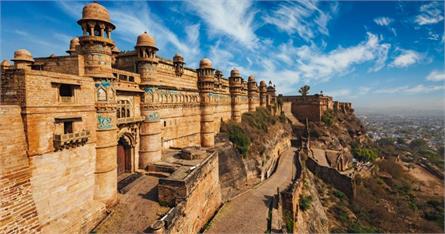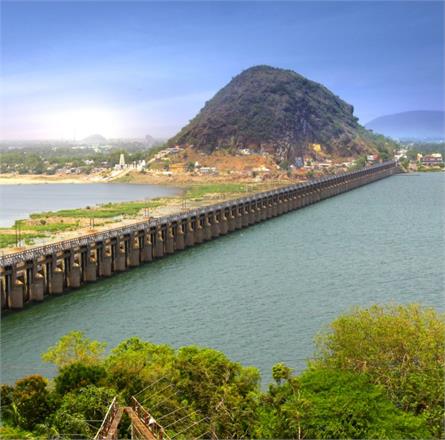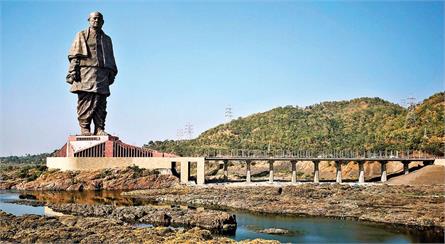Odisha - The Land of Lord Jagannath
Popular as Land of Lord Jagannath, Odisha is a beautiful state of India and is famous for its exotic seas, artistic temples, and attractive tourist spots. The state of Odisha is officially known as Orissa. Jagannath Puri Temple and Sun Temple of Konark are the renowned tourist destinations of Odisha. Apart from this, Odisha is also known for its paddy cultivation, exciting places as well as historical monuments. The art, culture, festivals, and music of Odisha give the state a unique identity.
Odisha is a state located on the eastern coast of the Indian subcontinent. The capital of Odisha is Bhubaneswar. This state is a special part of the country with modern infrastructure and facilities. After independence, there has been tremendous development in the rural areas of this state.
The province is famous for its cultural heritage, and the biggest attraction is classical Odissi dance form, also known as Orissi in older literature.
History of Odisha
The state of Odisha was famous in ancient times as 'Kalinga'. In the third century BCE (261 BCE), the Mauryan emperor Ashoka sent a powerful army to conquer Kalinga, which was fiercely faced by the inhabitants of Kalinga. Emperor Ashoka won Kalinga, but due to the terrible destruction of the war, the emperor's heartfelt aversion, and after Ashoka's death, Kalinga became independent again. In the second century BC, Kalinga became a powerful empire under the rule of Kharavela king. After Kharavela's death, Odisha's fame vanished. Samudragupta, who conquered in the fourth century invaded Odisha and defeated the five kings of this region. In 610, Odisha became the ruler of Shashank Naresh. After Shashank's death, Harshavardhana (Harsha Vardhana) conquered Odisha.
In the seventh century, Odisha was ruled by the Ganga dynasty. In 795 Maha Shiv Gupta Yajati II took over the reign and the most glorious chapter in the history of Odisha began. The state of Odisha grew a lot during the time of the rulers of the Ganga dynasty. The world-famous Sun Temple of Konark was built by the ruler of the Ganga dynasty, King Narasinga Deva. From the mid-16th century to 1592, Odisha was ruled by five Muslim kings. In 1592, Akbar subdued Odisha and included the region under his rule. After the fall of Mughals, the Marathas dominated Odisha, and it remained under Maratha rulers before the British government in 1803. On 1 April 1936, Odisha was made an independent province. After independence, the princely states of Odisha and its surroundings handed over their power to the Government of India. Odisha has many ancient names like Kalinga, Odra, Utkala, Tosala or Tosali and Kosala, but the region is mainly famous as the land of Lord Jagannath. Lord Jagannath is deeply associated with the social, cultural and religious life of Odisha. The people of Odisha are influenced by Jain, Christian and Islam religions at different times.
The history of Odisha is about 5,000 years old. Odisha became famous due to the Kalinga rule. Ashoka was the greatest Mauryan ruler who conquered almost the whole of India and the surrounding countries. Ashoka embraced Buddhism after witnessing many killings in the war. After his rule, the Gupta rule came in the fourth century. In the 10th century, the Bhauma-Kara dynasty and then the Soma dynasty ruled Odisha. Muslim rulers dominated here from the 13th and 14th centuries to 1568. Odisha has also seen the rule of the Nawabs and Marathas of Hyderabad. In 1803 AD, the British East India Company came to this state and became part of the modern history of Odisha. The coastal region of Bengal was converted into Bihar and Odisha. Later, Bihar and Odisha were divided into two different provinces in the year 1936, and Odisha officially became the state of India in 1950.
Geography of Odisha
Located on the eastern coast of India, Odisha is bordered by the beautiful seashore of the Bay of Bengal. The state of Chhattisgarh surrounds the state in the west, Andhra Pradesh in the south, West Bengal in the north-east, Jharkhand in the north, and Bay of Bengal in the east. The total area of Odisha is 1,55,707 sq km, which covers 4.74% area of the nation. Odisha has diverse habitats, greenery, and hilly areas. The sea terrain and river valleys of the state are amazing. Many deltas have been formed here due to major six rivers, such as the Mahanadi, Brahmani, Budhabalanga, Baitarani, Subarnarekha, and Rushikulya. The province has three main regions, such as plateaus, hills, and coastal plains. The natural habitat of wildlife is the major attraction of the state.
The state of Orissa falls between 17.780 and latitude 22.730 and longitude 81.37 East and 81.53 East. The coastal area of the state is about 450 km and has increased to 155,707 sq km in this area. This is equivalent to 4.87% of the total area of India. The state can generally be divided into four geographical regions. These are -
Northern Plateau,
Central River Basins,
Coastal Plains, and
Eastern Hills
Climate
Odisha is located in a tropical humid-arid (tropical savanna grassland) climate zone. The average temperature in Cuttack is around 26°C. January is the coldest and May is the hottest month of the state, with an average temperature of 20°C and 33°C, respectively.
The rainfall occurs in the months of July to September. The average annual rainfall in the state is around 1451.2 mm, which is even higher in the Eastern Ghats. The coastal areas of Chilka Lake are the driest, with an average rainfall of 939 mm.
Demography
According to the 2011 census, Odisha has a population of 4,19,74,218. The ratio of females to males is 978 females against 1000 males. Odisha has a literacy rate of around 72.9 percent, with males at 82 percent and women at 64 percent.
The population of the state is growing quite rapidly. The government has taken several steps to address female literacy and infant mortality. Basic facilities in Odisha are getting better, and facilities like hospitals, transport, education, and employment are also increasing.
Economy of Odisha
The economy of Odisha is growing steadily. In other words, the growth rate of the state is over the national average. The remarkable growth in the GDP of Odisha has been reported by the Ministry of Statistics and Programme Implementation.
More than 60% of the population of Odisha is engaged in agriculture, with a total cultivated area of 87.46 lakh hectares, of which 18.79 lakh hectares is irrigated. As Odisha is the major rice-producing state, rice is the primary crop of the state. There are many handicrafts and handloom small scale industries, which play a huge role in the economy of the state. The fishing business is also an important part of the state's economy.
The State of Odisha is making satisfactory progress in the field of Information Technology. The Government of Odisha, the National Institute of Governance and the National Informatics Center have jointly introduced a transparent and efficient system.
Agriculture
Agriculture has an important position in Odisha's economy. About 61.8% of the population of Odisha is engaged in agricultural work, although most of the land here is inaccessible or inadequate for more than one annual crop. Odisha has about 40 lakh farms with an average size of 1.5 hectares, but the per capita agricultural area is less than 0.2 hectares. About 45 percent of the total area of the state is a farming area. Rice, pulses, mesta, sugarcane, jute, turmeric, and coconut are important crops of the state, and cotton, tea, and rubber are the cash crops. Other important crops include ragi, jute, gram, mustard, sesame, maize, etc.
The availability of per capita agricultural land is decreasing due to rapid population growth.
Irrigation
Efforts have been made to increase irrigation capacity through large, medium and small projects and water exploitation projects. The irrigation system of 2,696 lakh hectares has been completed from the year 2004-2005. Six irrigation projects of 12,685-hectare irrigation have been identified in the 2005-06 season, out of which four schemes have achieved the target. In 2005-2006, the Odisha Lift Irrigation Corporation (OLIC) created 500 lift irrigation points under the 'Biju Krushak Vikas Yojana' (BKVY) and achieved the irrigation potential of 1,200 hectares.
The govt. of Odisha launched 'Nabakrushna Choudhury Seccha Unnayan Yojana' on November 22, 2017, which aims to provide the irrigation facility to about 55,000 hectares of agricultural land across Odisha.
Industry
Odisha also has excellent mineral production, which includes coal, lime, bauxite, iron ore and other minerals. It ranks third in the country in bauxite reserves. Rourkela Steel Plant (RSP) was the first integrated steel plant in the country, which is located in the city of Rourkela, Odisha. Essar, Neelachal Ispat Nigam Limited, POSCO, Steel Authority of India, Jindal Steel are some of the major industries and have played a meaningful role in the industrial sector of the state.
Industry Promotion and Investment Corporation Ltd., Industrial Development Corporation Ltd., and the Odisha State Electronics Development Corporation are the three major agencies providing financial assistance to the industries of the state. Workers and their family members have been provided health facilities in government hospitals. Child laborers engaged in industries were freed and were given admission under the National Child Labor Project for formal education and vocational training. There are 18 child labor projects in 18 districts across the state. About 33,843 child laborers have been admitted to schools run by the National Child Labor Project and 64,885 child laborers have been attempted to be mainstreamed through school education.
The industrial resources are notable in the state of Odisha. Odisha is ahead of all the states in India in the production of chromite, manganese ore and dolomite. It is also a pioneer in the production of high-quality iron-ore. Coal obtained from important Talcher mines located in the inner district of Dhenkanal provides energy for the smelting and fertilizer production of the state.
Education
Odisha has been a notable place of study from primary to higher education since ancient times. The remains of educational institutions of the past are still here. Formerly, the state was known as the 'hub of education.' Recently, a Buddhist study center of antiquity has been found in Ratnagiri in Jajpur district.
Now, the state has many famous universities. The prestigious NIT at Rourkela is the oldest and most renowned institution in the country, which was established in 1961. There are many science colleges, engineering colleges, and institutes of higher education. Odisha is also famous for its mass communication course as it houses IIMC. The prominent universities of Odisha are Kalinga Institute Of Industrial Technology, Fakir Mohan University, Orissa University of Agriculture & Technology, National Institute of Technology, Shri Jagannath Sanskrit Vishvavidyalaya, Biju Patnaik University of Technology Rourkela, Odisha.
Transportation in Odisha
Odisha receives many Indian and international tourists every year. Transportation in Odisha is also excellent like other states of India. Transport is given more and more importance due to the release of many development projects in the state. Odisha is attaining the status of a major tourism province. The state government is focusing on projects like the International Airport.
By Air: To reach Odisha by air, there is an airport in the capital Bhubaneswar. This airport has direct regular flights from Indian cities like Kolkata, Hyderabad, Nagpur, Mumbai, Delhi, Raipur, etc. Though, many airlines have made a departure and terminal point at Bhubaneswar Airport.
By Rail: Traveling to Odisha by rail is convenient as well as comfortable. Several trains connect Odisha to other corners of India. Bhubaneswar railway station is the most important railway station of Odisha. Major trains of Odisha including Rajdhani, Konark Express, Coromandel Express run from this station.
By Roadway: Odisha has an extensive network of roads, due to which, every corner of Odisha can be reached by road. Several expressways and roadways are passing through the state, with the help of which one can travel to Odisha. Driving on the roads of Odisha becomes even more interesting due to the presence of several national highways.
The capital of Odisha is accessible from the Bhubaneswar National Highway, which connects Chennai and Kolkata. Apart from this, National highway numbers 5, 6, 23, 42, and 43 passes through the state.
Languages of Odisha
Odia (Oriya) is the official language of Odisha, which is spoken by 84% of the total population of Odisha. Odia is also spoken in neighboring states of Odisha and recognized as one of the oldest languages in India. Hindi is the second most popular and widely accepted language. Apart from this, Telugu, Urdu, and Bengali are also spoken in the state. The English language is used only by the educated section and for official work. Sambalpuri is another major dialect of Odisha.
Cultural Life
The historical state of Odisha is inhabited by 62 distinct tribal communities, and all these communities have their own culture and tradition. Odisha has a rich artistic heritage and has created the best examples of Indian art and architecture. Artistic traditions are still practiced through graffiti, stone carving, and etching (popularly known as Patta painting) and painting on palm leaves.
Odisha is a bastion of rich tradition and culture and is reflected in its historical monuments, sculpture, artists, dance, and music. There is a department in the state which looks at culture and promotes it systematically. The culture of Odisha can be seen from ancient times through the traces of temples and monuments. There are many temples in this province, which are famous worldwide.
The classical dance Odissi was also born in the state and is now renowned worldwide. Apart from this, many folk dances and folk plays are also an integral part of the culture of Odisha. The culture is influenced by many religions, such as Jainism, Hinduism, and Buddhism. The tribes also hold a significant role in the culture of Odisha. Odisha's famous Rath Yatra is held in Puri and is performed with great devotion and reverence. It is famous all over the country, and one can see the rituals, culture, and traditions of the people. The handicrafts and handloom textiles are also a notable part of the state. Filigree work, picture frames, and ikat dresses are quite famous. The popular style of painting can be seen prominently, which can be seen in the scenes from Indian mythology and the Gods of Puri temple such as Jagannath, Balabhadra and Subhadra can also be noticed.
Dance and Music
There are many types of folk dance in tribal areas. Model and flute music is common in the villages. Odissi, the classical dance of Odisha, has been in existence for more than 700 years. Originally it was a temple dance performed for the Gods. The types, motions, postures, and gestures of the dance are inscribed on the walls of large temples, especially in Konark, as crafts and embossed etching. Chhau dance (a dance performed by masked artists), also spelled as Chau or Chhaau, is another heritage of Odisha culture. An art development center was established in Cuttack in 1952, which has a six-year duration teaching course for the promotion of dance and music. The National Music Association (National Music Committee) is also established in the state to promote the art of dance. There are other famous dance and music centers in Cuttack: Utkal Sangeet Samaj, Utkal Smriti Kala Mandap, and Mukti Kala Mandir.
Festivals
Odisha has its own way of celebrating fairs and festivals. The festivals of Odisha have their own special significance. These festivals play a significant role in highlighting the art, culture, and traditions of the state of Orissa. One of its unique festivals is the Boita Bandana (worship of boats) ritual celebrated in October or November (the date is fixed according to the Hindu calendar). Puri houses the Jagannath (Lord of the Universe) temple, which is one of the most famous temples in India. The annual Rath Yatra that takes place here attracts millions of people. A few kilometers from here is a Konark temple in the shape of a chariot of Lord Surya. This temple is one of the outstanding examples of medieval Oriya culture. Durga Puja, which is a festival celebrated in the months of September to October, Konark Dance Festival, and the journey of Lord Jagannath in the months of June-July, are worth visiting. Apart from this, one can also enjoy activities of sand art, fashion and rock shows, delectable food, and adventurous sports in Odisha.
- Durga Puja: Durga Puja is the most important festival of Odisha, which is celebrated majestically throughout the state. It is celebrated in the month of Ashwin or Karthik (September or October according to the Gregorian calendar). The huge sacred idols of Goddess Durga, along with two incarnations of Maa Lakshmi and Maa Saraswati, are decorated. Durga Puja, a religious festival, holds great significance for Hindu devotees. It is celebrated for three-four days in Odisha.
- Kalinga Festival: There is an interesting story related to the Kalinga festival of Odisha festival. A considerable part of Odisha was earlier known as Kalinga. The land has witnessed the brutal killings and death of martyrs in the era of Emperor Ashoka. After seeing the cruel destruction, King Ashoka decided to live a peaceful and nonviolent life. The Kalinga Festival is celebrated to mark the victory of peace over war. Various martial art acts are performed at Dhauli Shanti Stupa on the outskirts of Bhulishwar to pay tribute to the martyrs of the Maurya dynasty. Lively and brave performances of martial arts not only attract the people of Orissa but tourists from all over the world. This festival is celebrated on the 10th and 11th of January, every year.
- Chandan Festival: Chandan Yatra is a very famous festival in Odisha, also known as Gandhalepana Yatra. The longest festival Of Odisha is observed at the Jagannath temple in Puri. It is a 42-day long festival celebrated by worshiping the idols with sandalwood mixed water. In traditional boats called ‘Chapa,’ the deities are taken out of the temple for a sacred patron in the water. Decorated in red and white to give a swan-like shape, Boats are floating in the water. This festival is celebrated in April and May, where thousands of pilgrims gather in the celebration to participate in the glorious festival of Odisha.
- Konark Dance Festival: Dedicated to the beauty of the Sun Temple and classical dance of Odisha, Konark Dance Festival is the festival that goes beyond religions and customs. It is celebrated in Odisha from 1st December to 5th December, to pay tribute to the ancient beauty of the Konark temple. When the sun falls, the temple appears in a lively form, adding to its beauty even more. Konark Dance Festival is organized at the Konark drama pavilion (Konark) by the Odisha Dance Academy that belongs to Odisha’s dancer Gangadhar Pradhan. Various classical dancers from across the world, meet and entertain people at this extraordinary festival.
- Chariot Festival: The Rath Yatra, also known as the car festival or Chariot Festival, is the prominent festival among Odisha festivals. Dedicated to Lord Jagannath, Chariot festival is recognized as an incarnation of Lord Krishna and Lord Vishnu. The celebration of Rath Yatra represents the journey of Lord Krishna from Gokul to Mathura. Chariots of deities like Krishna, Balarama, and Subhadra are included in the yatra. This festival is celebrated in April or May, every year.
- Makar Mela: When the Sun enters the orbit of Capricorn, the festival of Makar Sankranti, also known as Makar Mela, is celebrated. People of the state pray to Sun God to give a healthy and prosperous life. The auspicious day is celebrated in the month of January.
- Puri Beach Festival: An annual celebration is celebrated for about five days in the month of November. During this festival, fashion shows, food, adventure sports as well as various cultural events and exhibitions make it a wonderful celebration.
Famous Food of Odisha
The cuisine of Odisha is famous all over the country. The mouth-watering dishes of the Odisha includes Chungdi Malai, Dalma, Dahi vada-Aloo dum. Apart from taste, the food of Odisha is also known for its nutritiveness. The simple yet distinctive style of cooking in Odisha has its own identity. Some of the famous food of Odisha are mentioned below:
- Khichdi: Khichdi is a simple but healthy and appetizing meal. It is one of the most important dishes in Odisha cuisine, which has also been offered as the main offering to Lord Jagannath in the Puri temple. The perfect combination of rice and lentils cooked together in ghee gives a unique and attractive taste. Mildly spiced, the dish is often served with yogurt.
- Dalma: Dalma is a lentil dish of Odisha. Without onion or garlic, it is made with roasted moong dal, which is mostly eaten with rice. Spices are added with vegetables to give it a hot-smacking taste. Moreover, it is enough to satisfy your hunger.
- Dahi vada-Aloo dum: Another popular street food in Odisha is Dahi vada-Aloo Dum. Everywhere, Aloo Dum and Dahi Vada are two different dishes, but one can get the blend of both in Odisha. This combination of the miraculous taste of dahi vada and the tanginess of aloo dum imparts a unique flavor. This dish is also famous as the 'Vada Pav' of Cuttack.
- Gupchup: The lip-smacking delicacy of Odisha, popularly known as Panipuri in western India, Golgappa in the north-India, Poochka in Bengal, and Gupchup in Odisha. The street food Gupchup needs no introduction. The best thing about this quick snack Gupchup is its price. It is cheaper in price and everyone's favorite.
Other tempting dishes include Chhena Poda, Macha Ghanta, Chungdi Malai, Kanika, Rasabali, Pakhala Bhata, Pilaf, or Pulao, Chaatu Rai, Aloo Potala Rasa, Santula. These appetizing cuisine of the state add extra charm to the beauty and attract the tourist.
Orissa is known mainly for milk-prepared sweets. Some of the typical sweeteners are Rasgola, Rasamalai, Chenapuda, Khirmahan, Rajabhaga, Rabri, Chinjahili, Rasabali (both made of milk), and Pitha (cake). Mahaprasad, the deity's food, is available only in temples and is cooked in pottery over a wood fire.
Shopping in Odisha
To shop in Odisha, add handicrafts and handlooms in your list. There is a deep penetration of aesthetic sense and artistry in the Odisha tradition, which is quite visible in the creations of handlooms.
Odisha carried forward the legacy of many religions. All of them have left a deep impression on the art of Odisha. At the same time, the strong tribal element has been also moved forward.
While wandering on the beaches, the traditional art of oysters will grab the attention. In tribal areas, metal artifacts are the most important item for shopping. Cigar boxes, jewelry, and decorative trays, with incredibly intricate silverwork, Pattachitra, folk painting of Orissa, paper mask masks from brassware applique, and colorful canopies are some of the popular items to be purchased from Orissa. The state is also home to exclusive silk and cotton handloom sarees and garments.
Best places to visit in Odisha
Odisha is a peaceful state located in the eastern corner of India adjacent to the Bay of Bengal. The ancient history of India still appears from its temples, chaityas, and stupas. Odisha, a rich heritage of two thousand years old, presents a glimpse of the golden history of the state from the Mauryan Empire to date. Since then, the state has witnessed many ups and downs in the history of India. Today, Odisha is the fastest developing state of the Indian Union. The state of Odisha offers beautiful and varied tourism with ancient monuments, unseen beaches, spiral rivers, large waterfalls, etc.
A trip to Odisha reveals the most significant and fiercest battles (Kalinga war) of Indian history were fought, due to which King Ashoka transformed into the greatest saint and followed the path of Buddhism from an emperor.
Touring to Konark will give a chance to see ancient Indian architecture. There are many temples in Bhubaneswar and Puri, which will make classical architecture and art.
Hirakud Dam
Hirakud Dam is one of the major tourist destinations of Odisha. Hirakud Dam is the longest human-made Dam in India, which is about 56 kilometers in length. This amazing Dam was built in the year 1956. There is a 21 km long drive-thru road on the Dam which gives a chance to walk inside the Dam.
Puri
Puri, land of various religious temples, is 60 kilometers south of the state capital of Bhubaneswar, located on the Bay of Bengal. The Jagannath Temple at Puri, the Sun Temple at Konark and the Lingaraja Temple at Bhubaneshwar are among the major sights of Odisha and attract devotees. The Jagannath temple in Puri is one of the char dhams (four abodes) of India.
Konark Sun Temple
Konark Sun Temple is a world-famous temple of Odisha and is also included in the list of UNESCO World Heritage Sites. The architecture of Konark Sun Temple makes the temple utterly different from other temples in India, and the temple is added to the list of famous monuments of India. The principal deity of the Konark Sun Temple is Lord Suryanarayana. The annual dance festival at the temple, the seashore surrounding it, and the Konark Sun Festival are among its major attractions.
Chilika Lake
Chilika Lake is one of the worth seeing places in Odisha, which is full of mesmerizing views. Chilika Lake, located near Mangalajodi, is an excellent destination to explore. Chilika Lake is the world's most coastal lagoon. Apart from this, one can also see birds like flamingos and kingfishers here.
Bhitarkanika National Park
Bhitarkanika National Park is one of the most beautiful places in Odisha, which has been known for hunting since ancient times. The serene environment of this place, colorful birds and sea turtles, as well as beautiful greenery, makes it an outstanding tourist destination.
Museum of Tribal Arts and Artifacts
The Tribal Museum is a beautiful museum located in Bhubaneswar, which holds the life story of the tribals of Odisha. While visiting the museum, one will get the facility of guides who will explain the tourists about the lifestyle of tribals in detail.
Udayagiri and Khandagiri Caves
Caves of Udayagiri and Khandagiri are among the most famous historical sites in Odisha and are located at a distance of about 6 km from Bhubaneswar. These caves are said to be one of the earliest caves built by the Jain community. Udayagiri stands for Sun Rise, and Khandagiri means Broken Hill. There are 18 caves located in Udayagiri and 15 in Khandagiri, of which Rani Cave is considered the most special.
Dhauli
Dhauli Giri hills are an extraordinary spot to visit in Odisha, which is also known as a Buddhist pilgrimage site. These hills are renowned all over the world for the Kalinga war. As a symbol of peace at this place, one must take advantage of seeing the Shanti Stupa, the famous Shiva temple, and the Buddha statue.
Odisha, ‘The Land of Lord Jagannath,’ has many important tourist spots that attract tourists from other states and countries. Tourists arrive in large numbers to visit Odisha and enjoy a glimpse of beautiful views.


